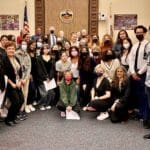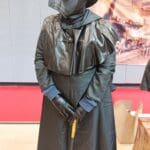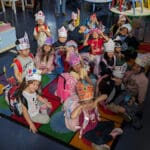The Building Empathy project has collaborated with KLRN to produce a poignant documentary on students learning about the unjust detainment of Japanese Americans during World War II. Building Empathy is a project of PEF and PUSD, with support from the California State Library and California Humanities. This three year project used historical examples as a platform to encourage students to grow their sense of empathy. The students learned about the impact of Executive Order 9066 during class, and had the opportunity to go a step further by visiting the Manzanar internment camp.
Following the students on their overnight experience, the documentary shows them experiencing the harsh living environment of Manzanar. They got to visit the barracks, play on the basketball court, and learn about what life was like for the Japanese Americans who were imprisoned there.
“Although I was a student teacher alongside my classmates in 2024, the experience that had the greatest impact on me was our trip to Manzanar. This is because it was one thing to create lesson plans and do research, but it was a whole new experience being able to step foot into what we initially only saw in black and white images.”
-Valentina M. (Blair, 10) (read more below)
The documentary also highlights Building Empathy’s other educational efforts. Activities such as student led classes, field trips, and visits from community leaders were among the ways Building Empathy encouraged student learning.
“Filming in Manzanar with students from the Building Empathy project was a powerful, memorable experience. I learned so much about the unique history of this place and relished the perspective of capturing it on camera. Truly an inspirational trip I will always remember.”
-Zack Stroff, Videographer
“Prior to landing in Pasadena a decade ago, I had a general sense about the Japanese American concentration camps and Executive Order 9066, but my knowledge base has been deepened by leading this project. Visiting Manzanar in April 2024 was the height of the three-year project that included organizing professional development sessions for teachers and students, artists and community visits to classrooms, ten field trips to the Japanese American National Museum and so much more. As a result of this project, so many more students and teachers in PUSD now know about an atrocity so close to home that has impacted the lives of so many people that are part of our community.”
-Sehba Sarwar, Student Engagement Manager
Building Empathy is supported in part by the State of California through the California Civil Liberties program, administered by the California State Library, and by the California Humanities Civics + Humanities Middle Grades Grants through California Humanities, a non-profit partner of the National Endowment for the Humanities.
Valentina M.’s Experience at Manzanar
Although I was a student teacher alongside my classmates in 2024, the experience that had the greatest impact on me was our trip to Manzanar. This is because it was one thing to create lesson plans and do research, but it was a whole new experience being able to step foot into what we initially only saw in black and white images.
It was really eye-opening to step foot into the bunkers first-hand, and it was really shocking to be able to see their grand size. Previously we had only seen a small-scale replication at the Japanese American National Museum and I wasn’t able to completely envision how it looked in real life. However, by seeing the bunkers actually lined up in Manzanar, I was able to gain a deeper perspective and was able to acknowledge how large of a scale everything was.
Similarly, I gained a deeper perspective by stepping foot into the restrooms and viewing the horrible conditions with my own eyes. The restrooms in particular shocked me, as I anticipated there to be at least a little bit of privacy, but the restroom lacked all forms of privacy and safety. Before visiting Manzanar, I didn’t give much through to where they had gone to the restroom during their time in the camps, and it was very horrifying to witness the terrible reality up close.
On the other hand, the trip was also eye-opening in a positive way. My biggest takeaway from visiting Manzanar was how despite the rough conditions that the Japanese-Americans were forced to face, they found ways to persevere. It was eye-opening to see how in spite of the injustices, they built beautiful gardens and kept family-sprit alive through art and traditions. It was a very positive experience being able to appreciate all the effort everyone had put into making the situation as manageable as possible, especially how they made these efforts for the kids and younger generations.
As a whole, visiting Manzanar was a positive experience and I learned a lot.






